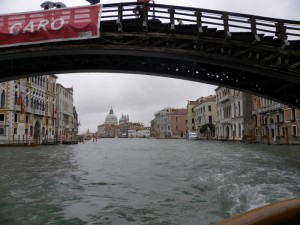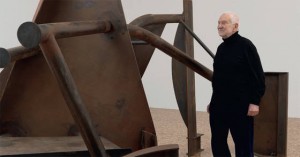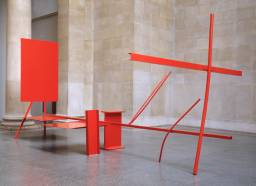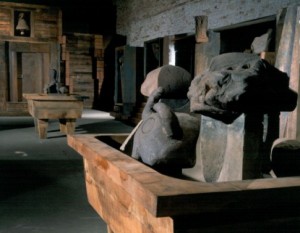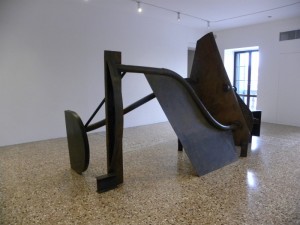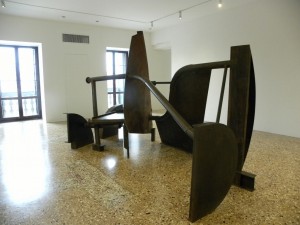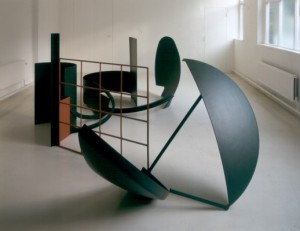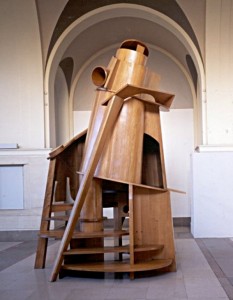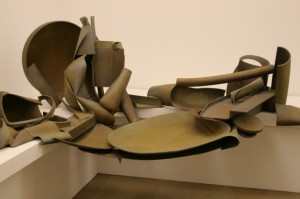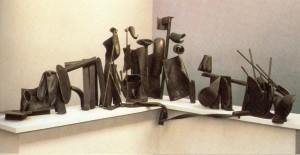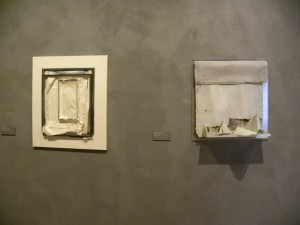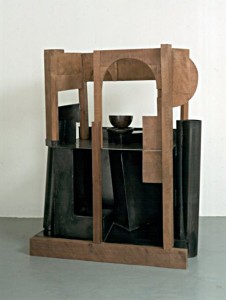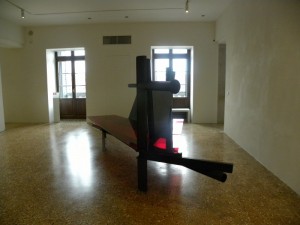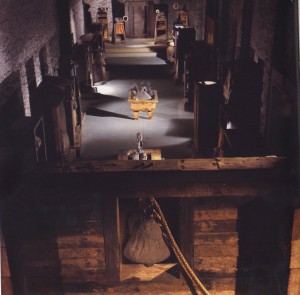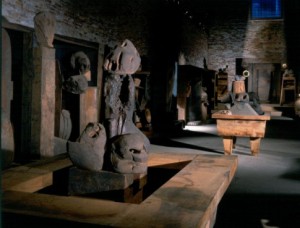HONORING ANTHONY CARO 1924-2013
I saw Anthony Caro’s exhibition at the Museo Correr on the Piazza San Marco in Venice on September 29 and he died on October 24 in London, so this exhibition is one of the last for which he supervised the installation (which he did with great precision.See the video of Caro installing his work at the Tate Gallery in London and talking about it.)
Caro, for me, is a reminder of my roots, my early career, as a believer in the idea that abstraction is an end in itself; that it is full of utopian meaning.
Caro was creating expressionist clay works under the influence of Henry Moore, although reacting against his smooth surfaces, when he came in contact with David Smith and Clement Greenberg in the early 1960s and entirely changed his vocabulary to abstract metal planes painted in bright colors, like Early One Morning from 1962.
Clement Greenberg’s ideas dominated my graduate studies in contemporary art in the early 1970s. I completely believed in Caro’s spare metal planes and space filling pieces as meaningful cerebral aesthetic statements .
Having giving little new thought to Caro during my many years of teaching, I was shocked when, in 1999, I saw his Last Judgment in Venice. It changed my perspective on Caro entirely. It was the antithesis of everything I thought I knew about him. Content heavy, mixed materials, full of the horrors of war. The material is a combination of stoneware, steel, cement, ceramic bronze, brass. It was spiritual, rather than religious, iconographically still abstract.
Now this spare exhibition in Venice. Nothing distracts from immersion in space and material. There is no explanation of metaphor, context, or significance. I am back to the early ideas of form in and of itself, and, surprisingly, because he is a consummate sculptor, he rivets me.
I know from his Last Judgement that Caro has many layers.
When you look for metaphors or meaning on his website, you will not find them: all the work is organized by materials and size. So I will simply give you some images and brief ideas here. There is a strong classical, expressionist, spiritual dimension in these abstract works.
It seems his own choice is to primarily give people an experience that is outside of time and place as in the Venetian exhibition. It is a utopian experience, we become absorbed entirely in the work, the use of industrial materials that create different textures, weights, directions, often overcoming gravity to float in the air. These issues become the only thing in the world. It is odd to go back to thinking this way and feel at the same time a strange sense of euphoria, as I realize that each sculpture is many sculptures, according to where you stand, that each sculpture is actually shaping our experiences, freeing us to think outside the here and now, into some sort of perfect world, where people don’t kill each other. Here is River Song above and below at two different angles.
At the Museo Correr, Caro sculpts space with his work. His work does not simply exist in space, it defines space. The early drawings show us his roots in Cubism, and specifically Picasso, pulled apart. He sees figures in space as strong straight lines.
The exhibition touches on every decade of the artist’s career. Hopscotch 1962 of corrugated aluminum, jumps up in steps like a pick up sticks game, rising against gravity. Red Splash, 1966 is one deep red color, 4 tubes and a mesh, also during this 1960s period when he was definitively moving away from Henry Moore’s bronze solids and toward open floating planes, under the inspiration of David Smith.
Garland 1970 is green curved steel creating a landscape.
Child’s Tower Room of 1983 – 84 has a different quality, perhaps because it is made of wood, actually a special wood, Japanese oak. It has more solids, a spiral inside to a platform, but no one can actually go up, there is a discontinuous stair. It points to the future in a return to more solid forms.
Dejeuner sur L’Herbe 1989 is rusted steel reaching out from a horizontal plane, the appearance of casting, but found shapes, and subtle patina: no color. Caro can build up density without clutter, he multiplies forms to a point where we can’t take it in in one look.
In the Triumph of Caesar, 1987, waxed steel, the two sides go vertically up from the plane, creating an angle like a pediment
Suddenly at the center of the exhibition are subtle paper sculpture made in Obama Japan in 1981 with Washi tissue.
Duccio Variations 1990 2000 an obvious choice for Venice with its examination of Duccio’s space (this is one in a series)
And in the last room, Venetian, 2011-12, with red plexiglass. It glows with the red of Venice and changes radically according to the light, as does the city itself. As my friend Pamela Allara said, she felt her eyes had been cleansed by the end of the show. I felt my brain had been cleansed as well and only my eyes remained.
The Last Judgement is exactly the opposite, it is heavy, weighted with the cares of humanity, its sins and suffering. The installation has 25 separate “episodes” beginning with Dante’s boatman, Charon. It continues on the left with Without Mercy, Greed and Envy, Shades of Night, Prisoners, Hell is a City, Flesh, Civil War, Jacob’s Ladder. On the left side are Confessional, Unknown Soldier, Torture Box, Teiresias, Tribunal, Judas, Elysian Fields, Poison Chamber, Salome Dances, and The Furies In the middle is the Bell tower entrance, Door of Death, still life with skulls and sacrifice all culminating in the four last trump[et]s leading up to the final Gate of Heaven. The topics mix literary, classical, biblical, legal, and religious ideas.
The 1999 brochure accompanying the display links it to the artist’s disgust and horror with the “so called ‘ethnic’ cleansing in Bosnia, Rwanda and most recently with the worsening conflict in Kosovo. As a Jew he has been asked more than once to make a sculpture commemorating the Holocaust but has felt unable to undertake it as the subject is too terrible, too enormous to do justice to. However in 1992, working with the ceramicist Hans Spinner in the South of France, Caro made some ceramic pieces which resembled heads. When they were shipped back to his London studio they became the basis for his Trojan War sculptures, which were shown in the form a battlefield . . In a sense the sculpture is nothing less than Caro’s own Guernica . . . .It is fitting that with a century that began with the Gates of Hell of Auguste Rodin should now close with the Last Judgment of Anthony Caro. “
This material appears nowhere online. In researching Caro’s Last Judgment I only found one description linking it to World War II! Why is that? It is because these powerful, misshapen forms redefine all of his work: they bring together his deep sense of material and space with a specificity and direct sense of tragedy. Each sculpture is purposefully enclosed in a rectangular box, physically containing the tortured themes. The abstracted forms evoke direct associations with the history depicted. It is as though Caro, after a lifetime of efforts to create utopian spaces on earth, is now acknowledging here (as well as in his Trojan War series, )that what we have is the opposite.
The weighty catalog provides context, but no interpretation of the work itself: there is art history “’The Last Judgement’ in Western art, as well as essays “When Art Meets Politics by Nadine Gorimer, “Violence Between Individiuals Groups and States,” Robert Hinde, poetry by Hans Magnus Enzensberger, and potent quotations accompanying stunning close up photographs of the installation.
Perhaps the reason so little appears online is because the Last Judgement is in the collection of the Kunsthalle Wurth in Künzelsau, Germany, a small town near Heidelberg in Germany, that opened in 2001. From the website it is not clear if it is on permanent display, but the Wurth Museum co- sponsored the display in Venice with the British Council and the Peggy Guggenheim Foundation.
It was shown in the Antique Granary in the Giudecca, the spare industrial space enhancing the overall sense of horror of the individual pieces. Collectively, the pieces point toward The Gate of Heaven, as the climax of the path through the darkness of human actions. The Gate is an open door, as though it is enticing us to pass through, in spite of the sins behind us. But it is ambiguous if anyone is actually going to be admitted, there is no judge, there is no Saint Peter, there is no sense of salvation. Only an open door surrounded by sculptures that make reference to four trumpets that play at the resurrection
(one can’t help but think of Handel’s Messiah). So in the end Caro’s message is to offer the possiblitiy of salvation, just as his abstract nature based sculptures offer the possibility of utopia. The choice is ours which way we choose to go.
We have lost one of the greatest sculptors of the twentieth century.
This entry was posted on December 5, 2013 and is filed under Art and Politics Now, Contemporary Art, Modern Sculpture, Venice Biennale.

